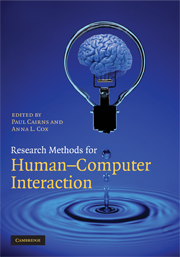Book contents
- Frontmatter
- Contents
- List of figures
- List of tables
- List of contributors
- Preface
- 1 Controlled experiments
- 2 Questionnaires, in-depth interviews and focus groups
- 3 Eyetracking in HCI
- 4 Cognitive modelling in HCI research
- 5 Formal analysis of interactive systems: opportunities and weaknesses
- 6 Using statistics in usability research
- 7 A qualitative approach to HCI research
- 8 Methodological development
- 9 Theoretical analysis and theory creation
- 10 Write now!
- 11 Applying old research methods to new problems
- References
- Index
3 - Eyetracking in HCI
Published online by Cambridge University Press: 05 April 2016
- Frontmatter
- Contents
- List of figures
- List of tables
- List of contributors
- Preface
- 1 Controlled experiments
- 2 Questionnaires, in-depth interviews and focus groups
- 3 Eyetracking in HCI
- 4 Cognitive modelling in HCI research
- 5 Formal analysis of interactive systems: opportunities and weaknesses
- 6 Using statistics in usability research
- 7 A qualitative approach to HCI research
- 8 Methodological development
- 9 Theoretical analysis and theory creation
- 10 Write now!
- 11 Applying old research methods to new problems
- References
- Index
Summary
Overview
Eyetracking records eye movement and provides information on what people look at. Understanding how people look gives researchers an insight into how people think, especially in areas of cognition such as attention. The advantage of eyetracking is that it also gathers this information in real time and to a high level of detail.
The eye movement recorded by eyetrackers is a combination of two main behaviours: first, fixations, where the eye is relatively still; second, saccades, where the eye moves rapidly between fixations (Rayner, 1998; Salvucci and Goldberg, 2000). Fixations are usually of more interest, since these are the times when the eye receives the most detailed information.
The academic world has investigated tracking eye behaviour for over 100 years. However it really started to flourish in the 1960s and 1970s, being used in the realms of cognitive sciences, language and advertising (Jacob and Karn, 2003; Rosbergen, 1998, cited by Radach et al., 2003). In the past few years however, it has been used more widely in academia and commercially. Early eyetrackers were very expensive and used bespoke equipment and software. They were also cumbersome for participants as sensitivity to head motion meant equipment such as bite bars and chin rests were used to reduce movement (see Figure 3.1). Advances in technology have greatly decreased the cost of eyetracking equipment and improved its accessibility and marketability.
- Type
- Chapter
- Information
- Research Methods for Human-Computer Interaction , pp. 35 - 69Publisher: Cambridge University PressPrint publication year: 2008
- 8
- Cited by



